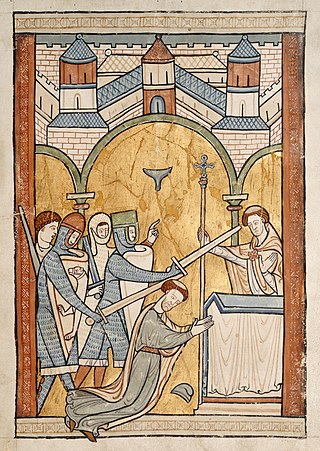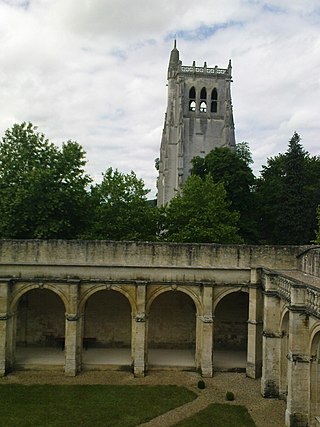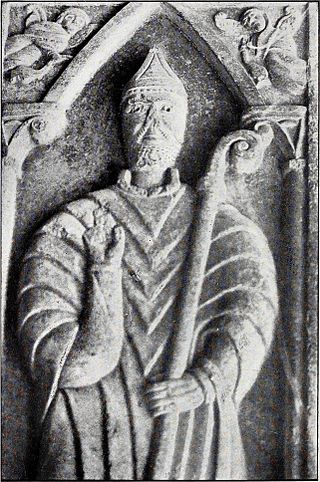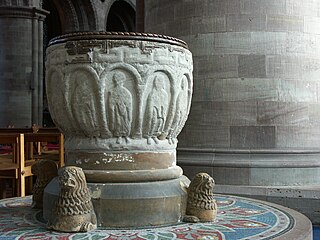Related Research Articles
Richard was a medieval Benedictine monk and Archbishop of Canterbury. Employed by Thomas Becket immediately before Becket's death, Richard arranged for Becket to be buried in Canterbury Cathedral and eventually succeeded Becket at Canterbury in a contentious election. Much of Richard's time as archbishop was spent in a dispute with Roger de Pont L'Evêque, the Archbishop of York over the primacy of England, and with St Augustine's Abbey in Canterbury over the archbishop's jurisdiction over the abbey. Richard had better relations with King Henry II of England than Becket had, and was employed by the king on diplomatic affairs. Richard also had the trust of the papacy, and served as a judge for the papacy. Several of his questions to Pope Alexander III were collected into the Decretals, a collection of ecclesiastical laws, and his patronage of canon lawyers did much to advance the study of canon law in England.
William de Vere was Bishop of Hereford and an Augustinian canon.
Paul L. Maier is a historian and novelist. He has written several works of scholarly and popular non-fiction about Christianity and novels about Christian historians. He is the former Russell H. Seibert Professor of Ancient History at Western Michigan University, from which he retired in 2011, retaining the title of professor emeritus in the Department of History. He previously served as Third Vice President of the Lutheran Church–Missouri Synod.

Roger de Pont L'Évêque was Archbishop of York from 1154 to 1181. Born in Normandy, he preceded Thomas Becket as Archdeacon of Canterbury, and together with Becket served Theobald of Bec while Theobald was Archbishop of Canterbury. While in Theobald's service, Roger was alleged to have committed a crime which Becket helped to cover up. Roger succeeded William FitzHerbert as archbishop in 1154, and while at York rebuilt York Minster, which had been damaged by fire.

Reginald Fitz Jocelin was a medieval Bishop of Bath and an Archbishop of Canterbury-elect in England. A member of an Anglo-Norman noble family, he was the son of a bishop, and was educated in Italy. He was a household clerk for Thomas Becket, but by 1167 he was serving King Henry II of England. He was also a favourite of King Louis VII of France, who had him appointed abbot of the Abbey of Corbeil. After Reginald angered Becket while attempting to help negotiate a settlement between Becket and the king, Becket called him "that offspring of fornication, that enemy to the peace of the Church, that traitor." When he was elected as a bishop, the election was challenged by King Henry's eldest son, Henry the Young King, and Reginald was forced to go to Rome to be confirmed by Pope Alexander III. He attended the Third Lateran Council in 1179, and spent much of his time administering his diocese. He was elected Archbishop of Canterbury in 1191, but died before he could be installed.

Josceline de Bohon or Bohun was an Anglo-Norman religious leader.
Gerard la Pucelle was a peripatetic Anglo-French scholar of canon law, clerk, and Bishop of Coventry.

Sir Reginald FitzUrse (1145–1173) was one of the four knights who murdered Thomas Becket in 1170. His name is derived from Fitz, the Anglo-Norman French term meaning "son of" and urse meaning a bear, probable the nom de guerre of his ancestor. Although he lived before the true age of heraldry which developed in the early 13th century, his shield bore the cognizance of a bear, which is visible in a contemporary drawing portraying the murder of Becket.

Hugh Nonant was a medieval Bishop of Coventry in England. A great-nephew and nephew of two Bishops of Lisieux, he held the office of archdeacon in that diocese before serving successively Thomas Becket, the Archbishop of Canterbury and King Henry II of England. Diplomatic successes earned him the nomination to Coventry, but diplomatic missions after his elevation led to a long delay before he was consecrated. After King Henry's death, Nonant served Henry's son, King Richard I, who rewarded him with the office of sheriff in three counties. Nonant replaced his monastic cathedral chapter with secular clergy, and attempted to persuade his fellow bishops to do the same, but was unsuccessful. When King Richard was captured and held for ransom, Nonant supported Prince John's efforts to seize power in England, but had to purchase Richard's favour when the king returned.

Bartholomew of Exeter was a medieval Bishop of Exeter. He came from Normandy and after being a clerk of the Archbishop of Canterbury, was made Archdeacon of Exeter in 1155. He became Bishop of Exeter in 1161. Known for his knowledge of canon law, he was involved in the Becket controversy after the appointment of Thomas Becket as Archbishop of Canterbury. After Becket's death, although he was frequently at the royal court, he mainly attended to his diocese. A number of works by him survive, including sermons and treatises on law and theology.

Robert Foliot was a medieval Bishop of Hereford in England. He was a relative of a number of English ecclesiastics, including Gilbert Foliot, one of his predecessors at Hereford. After serving Alexander, Bishop of Lincoln as a clerk, he became a clerk of Henry of Blois, the Bishop of Winchester and brother of King Stephen of England. He attended the Council of Reims in 1148, where another relative, Robert de Chesney, was elected as Bishop of Hereford. Chesney then secured the office of Archdeacon of Oxford for Foliot.
John de Pageham was a medieval Bishop of Worcester.
William of Northall was a mediaeval Bishop of Worcester.

The Government of Delaware encompasses the administrative structure of the US state of Delaware as established by its 1897 constitution. Analogously to the US federal government, it is composed of three branches: executive, legislative, and judicial. The Governor is head of the executive, the General Assembly is the legislature, and the Supreme Court is the highest court. The state is also organized into counties, municipalities, school districts, and special districts.
Gervase de Cornhill was an Anglo-Norman royal official and sheriff. Beginning his royal service as a justice in London in 1147, he continued to serve both King Stephen of England and Henry II until his death around 1183. He played a minor role in the Becket controversy in 1170.
Benet of St Albans was a medieval English monk and biographer of Thomas Becket.

Brachymystax tumensis, the blunt-snouted lenok, is a salmonid fish distributed in rivers and lakes in Eastern Asia. It was formerly included in the more widespread species Brachymystax lenok, but more recent research based on differences in morphology and genetics have justified a distinction of the two species.
Sheriff's aid was a medieval supplementary payment by landowners to the sheriffs and their staffs.
Sibyl of Falaise was a kinswoman of King Henry I of England. She was possibly his illegitimate daughter or a niece, as the sources are unclear. Another possibility is that she may have been more distantly related to him instead. She married and had at least one daughter, although her husband's other children may possibly be her offspring also. Through her daughter, Sibyl was the grandmother of Reginald fitzUrse, one of the murderers of Thomas Becket.

2MASS J15104761–2818234, sometimes shortened to 2M1510, is a triple or possibly quadruple brown dwarf system, consisting of the eclipsing binary 2M1510A and the wide companion 2M1510B. 2M1510A was found to be an eclipsing binary in the first light data of the SPECULOOS telescopes. It is only the second eclipsing binary brown dwarf found so far, the other is 2M0535-05. The system verified theoretical models for how brown dwarfs cool. The system is located 120 light-years away from earth in the constellation Libra.